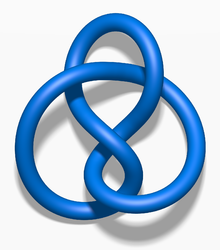4 1 knot
| Figure-eight knot | |
|---|---|
 |
|
| Common name | Figure-eight knot |
| Arf invariant | 1 |
| Braid length | 4 |
| Braid no. | 3 |
| Bridge no. | 2 |
| Crosscap no. | 2 |
| Crossing no. | 4 |
| Genus | 1 |
| Hyperbolic volume | 2.02988 |
| Stick no. | 7 |
| Unknotting no. | 1 |
| Conway notation | [22] |
| A-B notation | 41 |
| Dowker notation | 4, 6, 8, 2 |
| Last /Next | 31 / 51 |
| Other | |
| alternating, hyperbolic, fibered, prime, fully amphichiral, twist | |
In knot theory, a figure-eight knot (also called Listing's knot) is the unique knot with a crossing number of four. This makes it the knot with the third-smallest possible crossing number, after the unknot and the trefoil knot. The figure-eight knot is a prime knot.
The name is given because tying a normal figure-eight knot in a rope and then joining the ends together, in the most natural way, gives a model of the mathematical knot.
A simple parametric representation of the figure-eight knot is as the set of all points (x,y,z) where
for t varying over the real numbers (see 2D visual realization at bottom right).
The figure-eight knot is prime, alternating, rational with an associated value of 5/2, and is achiral. The figure-eight knot is also a fibered knot. This follows from other, less simple (but very interesting) representations of the knot:
(1) It is a homogeneousclosed braid (namely, the closure of the 3-string braid σ1σ2−1σ1σ2−1), and a theorem of John Stallings shows that any closed homogeneous braid is fibered.
(2) It is the link at (0,0,0,0) of an isolated critical point of a real-polynomial map F: R4→R2, so (according to a theorem of John Milnor) the Milnor map of F is actually a fibration. Bernard Perron found the first such F for this knot, namely,
where
The figure-eight knot has played an important role historically (and continues to do so) in the theory of 3-manifolds. Sometime in the mid-to-late 1970s, William Thurston showed that the figure-eight was hyperbolic, by decomposing its complement into two ideal hyperbolic tetrahedra. (Robert Riley and Troels Jørgensen, working independently of each other, had earlier shown that the figure-eight knot was hyperbolic by other means.) This construction, new at the time, led him to many powerful results and methods. For example, he was able to show that all but ten Dehn surgeries on the figure-eight knot resulted in non-Haken, non-Seifert-fibered irreducible 3-manifolds; these were the first such examples. Many more have been discovered by generalizing Thurston's construction to other knots and links.
...
Wikipedia
